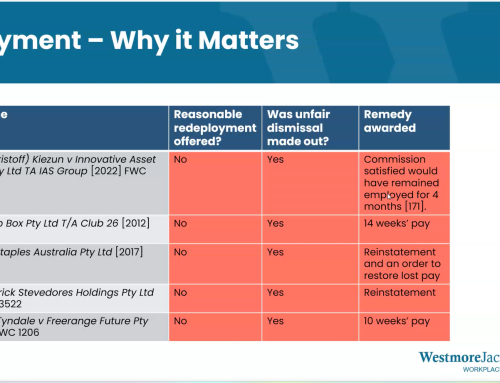
Businesses of today exist in a very competitive environment. Competition can be fierce, and the fight to retain one’s existing clients is crucial for business survival. It is, therefore, incumbent upon most businesses to take proactive steps to defend their turf.
One step to reduce the risk of ex-employees from taking your clients is to include post-employment restraints in employment contracts.
Enforcing post-employment restraints against ex-employees can be particularly difficult. To the casual observer, it may seem that Courts take a highly technical approach to post-employment restraints, resulting in many restraints being unenforceable.
The legal principles that the Courts apply to post-employment restraints are strict. This means it is often an uphill battle for employers to get a ruling in their favour to enforce post-employment restraints. This is particularly so when the circumstances of the case do not support an employer’s assertion that a legitimate or protectable business interest exists. If an employer cannot convince a Court that a legitimate business interest exists, then it is highly likely the post-employment restraint will be unenforceable.
Anecdotally, many employers underestimate the importance the ‘factual matrix’ has on the potential enforceability of post-employment restraints. To give some guidance to this complex issue we thought a quick preview would be helpful.
The following factors have shown to influence whether a post-employment restraint is enforceable.
Employment Agreement or Commercial Agreement, or Both?
If an agreement between an employee and an employer includes a commercial element, such as the employee also being a part-owner of the business, a Court may be more inclined to decide a post-employment restraint is enforceable. In Pearson v HRX Holdings
Nature of Relationship with Your Clients
A close relationship between an employee and an employer’s clients can mean a Court is more likely to decide that a post-employment restraint is enforceable. An employee’s ability to connect with clients in such a way that it appeared to witnesses as if he were “sprinkling fairy dust” on clients, was a factor that contributed to enforceability of the restraint at first instance in Pearson (upheld on appeal).
Seniority
The seniority of an employee can be a make-or-break factor in enforcing restraints. It is hard to foresee circumstances where a post-employment restraint against a casual Cash Register Operator would be enforceable (other than perhaps restraints dealing with confidential information). Alternatively, an employer has a much better chance of enforcing a restraint against a Senior Sales Executive.
Access to Confidential Information
Employees privy to highly commercially sensitive information are at a higher risk of having a post-employment restraint enforced against them. If an employee has access to information such as customer lists, sales margins, expansion plans or operating costs, this might point towards a restraint being more likely to be enforced.
Negotiation
Courts have shown a greater willingness to enforce post-employment restraints that have been negotiated than those provided to employees on a “take it or leave it basis”. Evidence of some back-and-forth negotiation regarding the scope of a restraint can have a bearing on a Court’s decision on whether a post-employment restraint is enforceable.
Conclusion
These are just some of the circumstances that can indicate whether a post-employment restraint will be enforceable. Many more factors can be relevant in deciding whether a restraint is enforceable, particularly the restraint’s wording.
If you are concerned your company’s post-employment restraints may be unenforceable, then consider having them checked by an employment lawyer. A well-drafted post-employment restraint may be your last line of defence in preventing ex-employees from poaching your clients.
Adam Colquhoun, Principal
This article is general information only. If you need legal advice, then please contact us.
Liability limited by a scheme approved under Professional Standards Legislation






Leave A Comment